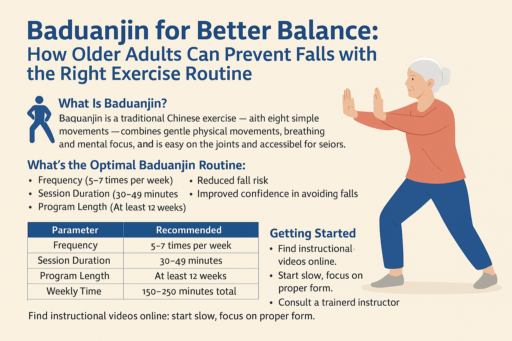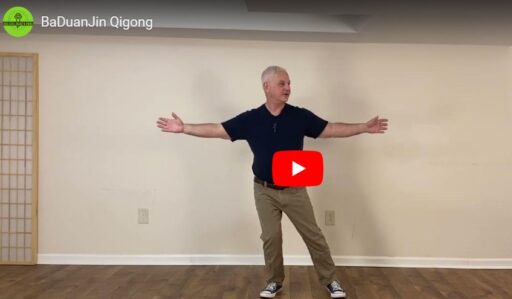Falls are one of the leading causes of injury and death among older adults. With age, balance tends to decline due to reduced muscle strength, slower reflexes, and changes in vision and coordination. But there’s good news: practicing Baduanjin—a form of Qigong—can significantly improve balance and reduce the risk of falls.
As reported by the journal Frontiers in Public Health, a recent meta-analysis of 40 controlled studies has pinpointed not only the benefits of Baduanjin but also the best way to practice it for optimal results.
Here’s what older adults, caregivers, and health professionals need to know.
🧘♂️ What Is Baduanjin?
Baduanjin (pronounced bah-dwan-jin) is an ancient Chinese exercise consisting of eight simple movements. It combines gentle physical movements, breathing, and mental focus. Unlike many high-impact fitness programs, Baduanjin is easy on the joints and accessible to most seniors, including those with chronic conditions.
✅ The Benefits of Baduanjin for Balance
The review found that Baduanjin significantly improves various aspects of balance:
- Static balance (e.g., standing on one leg)
- Dynamic balance (e.g., walking and transitioning between sitting and standing)
- Proactive balance (e.g., initiating movement safely)
- Overall balance test scores (e.g., Berg Balance Scale)
Additionally, participants showed:
- Reduced fall risk
- Improved confidence in avoiding falls
These results were consistent across healthy individuals and those with health issues like stroke, osteoporosis, or Parkinson’s.
Online Course of Baduanjin
Learn the 8 movements and breathing techniques of Baduanjin from ATCQA Certified Master Instructor, Peter Hodes, through a self-paced video class.
Also included in the course: in-depth knowledge about how Baduanjin can benefit various health conditions.
📏 What’s the Optimal Baduanjin Routine?
To gain the best balance improvements, follow these evidence-based parameters:
| Parameter | Recommended |
| Frequency | 5–7 times per week |
| Session Duration | 30–49 minutes |
| Program Length | At least 12 weeks |
| Weekly Time | 150–250 minutes total |
💡 Note: Improvements begin to show after 12 weeks, with continued progress over 20–26 weeks.
⚖️ Why It Works
Baduanjin trains balance through:
- Repetitive weight shifts
- Controlled body movements
- Enhanced proprioception (body awareness)
- Mindful breathing that reduces anxiety and improves focus
It engages multiple systems at once—muscular, sensory, and neurological—making it highly effective.
⚠️ Things to Watch Out For
While Baduanjin is generally safe, too-long sessions (over 50 minutes) may lead to fatigue or discomfort. Stick to moderate, consistent practice for the best results.
Also, many of the studies reviewed had limitations like lack of blinding and follow-ups, so while the results are promising, more high-quality research is needed.
👟 Getting Started
You can find free Baduanjin instructional videos online, including official guides from the Chinese General Administration of Sport. Start slow, focus on proper form, and if needed, consult a trained instructor.
👴 “Baduanjin has become my daily habit. I feel more stable, less afraid of falling, and more relaxed overall,” says a 72-year-old practitioner.
📌 Takeaway
Baduanjin is a practical, low-impact, and effective way for older adults to improve their balance and reduce the risk of falls. With just 30 minutes a day, five days a week, it’s a habit that can add stability—and peace of mind—to daily life.

